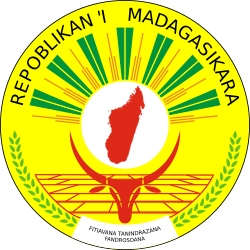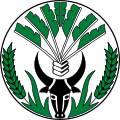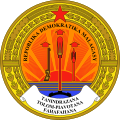A request that this article title be changed to Emblem of Madagascar is under discussion . Please do not move this article until the discussion is closed. |
| Seal of Madagascar | |
|---|---|
 | |
| Armiger | Republic of Madagascar |
| Adopted | 2011 |
| Motto | Tanindrazana, Firaisankina, Fanorenana "Homeland, Solidarity, Renew" "Patrie, Solidarité, Rénovation" |
The seal of Madagascar (French: Sceau de Madagascar) includes an outline map of the island at the center (together with two smaller islands nearby: the Glorioso Islands and Tromelin Island), and below it the head of a zebu. Colors used are red, green, yellow, black, and white. Green and red rays emanate from the map, making it look like the sun and also the Ravenala , a plant typical of Madagascar.
The seal is surrounded by Malagasy. The upper part of the emblem written the official name of the country: REPOBLIKAN'I MADAGASIKARA ("Republic of Madagascar" in English or "République de Madagascar" in French) and at the base bears the national motto: TANINDRAZANA - FIRAISANKINA – FANORENANA (Homeland - Solidarity - Renew in English or "Patrie - Solidarité - Renouveau" in French). Various versions of the Constitution Article 4 have used other mottos.







